Cite this document
(“New Architecture Essay Example | Topics and Well Written Essays - 1500 words”, n.d.)
Retrieved from https://studentshare.org/environmental-studies/1420500-new-architecture
Retrieved from https://studentshare.org/environmental-studies/1420500-new-architecture
(New Architecture Essay Example | Topics and Well Written Essays - 1500 Words)
https://studentshare.org/environmental-studies/1420500-new-architecture.
https://studentshare.org/environmental-studies/1420500-new-architecture.
“New Architecture Essay Example | Topics and Well Written Essays - 1500 Words”, n.d. https://studentshare.org/environmental-studies/1420500-new-architecture.


